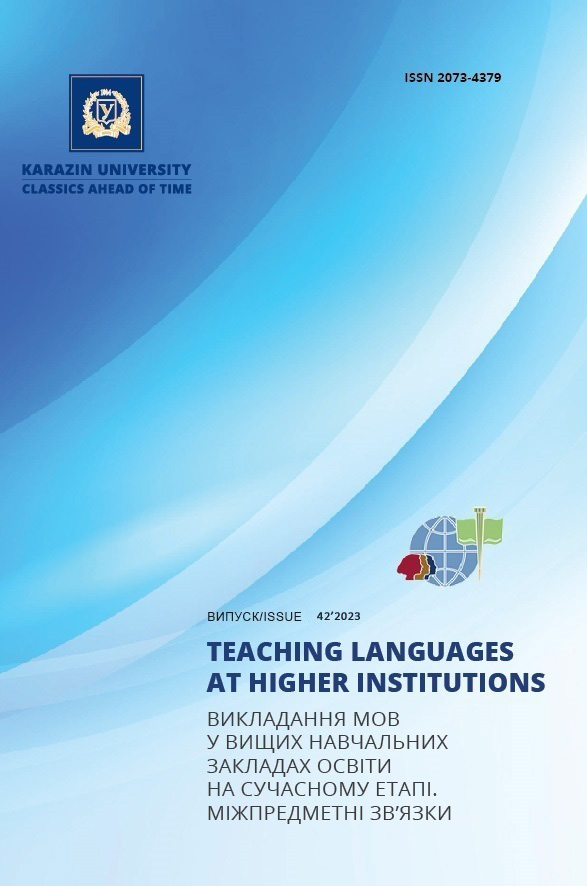Munchʼs “Scream” as a sense-giving object for the conceptual entity
Abstract
A conceptual entity is a phenomenon that only exists in our thoughts as knowledge, linguistic, cultural, iconic, etc. All objects falling under this category are those that were created only by human intellect (power of eason or emotions). The article focuses on how a conceptual idea about the object chosen or given for in-depth discussion or study in an academic setting might be constructed and how the sense-giving potential of this object forms the conceptual entity. In this context, the object acts as a symbol for the idea and transforms into a sense-making tool that affects how linguistic or visual patterns manifest in the human mind. The articleʼs goal is to illustrate the problem of the expansion of every field of knowledge through the development of new concepts. This goal involves visual art as a reference point, notably Edvard Munchʼs Scream series becoming an object for idea generation. Practically, conceptualization strategies can make teaching a foreign language easier. The use of visual art images as nonverbal communication tools gives teachers a chance to improve studentsʼ discourse skills. The cognitive approach to understanding the scream image in the artwork enables us to connect it to symbolic qualities that heighten its emotional resonance and give it fundamentally indivisible characteristics. This article takes a cognitive approach to communication. Hence, teaching it involves developing mental representations of the conversational subject and its linguistic realizations.
As the result, considering the object (image) as a conceptual phenomenon of visual culture gives the following sequence of causal modes of its cognition: stimulation – intentional stances and cognitive attitude – mentalization / presence of mental content – ideation / reasoning / presence of substantial content – conceptualization. All of these are either postures or processes in which a kind of object appears, depending on the psychodynamic or psychoemotional state of its meditator, more specifically: stimulus object – intentional object – mental object – ideative object – substantial object / semantic object – conceptual object. So, Munchʼs conception of the scream has not assumed a stable character, we are not inclined to consider the scream as a concept and leave it to us to designate it as a conceptual sense-given object. Future studies might focus on creating conceptual frameworks for the language learning process.
Downloads
References
Akhtar-Khavari, A. (2015). Fear and Ecological (In)Justice in Edvard Munchʼs the Scream of Nature. NAVEIÑ REET: Nordic Journal of Law and Social Research. Special Issue on Law and Art [online]. 2 (6), pp. 130–151. Available at: https://ssrn.com/abstract=2688781 [Accessed 01 March 2023].
Bischoff, U. (2011). Edvard Munch. Cologne, Germany: Taschen GmbH.
Dennett, D.C. (1998). The Intentional Stance. 7th ed. Cambridge, Massachusetts, London, England: A Bradford Book, The MIT Press. First published in 1987.
Edvard Munch: Symbols and Images. (1978). Washington: National Gallery of Art.
Edvard Munchʼs Writings. emunch.no [online]. Available at: https://www.emunch.no/english.xhtml [Accessed 01 March 2023].
Fonagy, P., Gergely, G., Jurist, E.L., Target, M. (2002). Affect regulation, mentalization and the development of the self. New York: Other Press.
Głuchowska, L. (2013). Munch, Przybyszewski and The Scream. Kunst og Kultur, 96 (4), pp. 182–193. DOI: https://www.idunn.no/doi/10.18261/ISSN1504-3029-2013-04-03.
Messer, T.M. (1985). Edvard Munch. New York: Harry N. Abrams, Inc., Publishers.
Munch, E. (2005). The Private Journals of Edvard Munch: We are flames which pour out of the earth. Holland, J.G. (Ed. and transl.); Høifødt, F. (Forward). Madison, Wisconsin: The University of Wisconsin Press.
Pitman, A. (2011). Edvard Munch (1863-1944) The Scream. The British Journal of Psychiatry, 198 (1), pp. 72–72. DOI: https://doi.org/10.1192/bjp.198.1.72.
Prideaux, S. (2012). Edvard Munch: Behind the Scream. 3d ed. New Haven and London: Yale University Press.
Roberti, F. (1962). Dictionary of Moral Theology. Westminster, Md.: Newman Press.
Talmy, L. (2000). Toward a Cognitive Semantics. Vol. I: Concept Structuring Systems. Cambridge, Massachusetts, London, England: A Bradford Book, The MIT Press. DOI: https://doi.org/10.7551/mitpress/6847.001.0001.
Tsur, R. (2008). Toward a Theory of Cognitive Poetics. Brighton, Portland, Toronto: Sussex Academic Press. DOI: https://doi.org/10.1075/p&c.17.2.12fre.
VandenBos, G.R. (Ed.). (2015). APA Dictionary of Psychology. 2nd ed. Washington, DC: American Psychological Association.
Volkov, S.A. (2022). Ideation in its adaptation to the educational process. Research Result. Pedagogy and Psychology of Education, 8 (1), pp. 64–75. DOI: https://doi.org/10.18413/2313-8971-2022-8-1-0-6.

